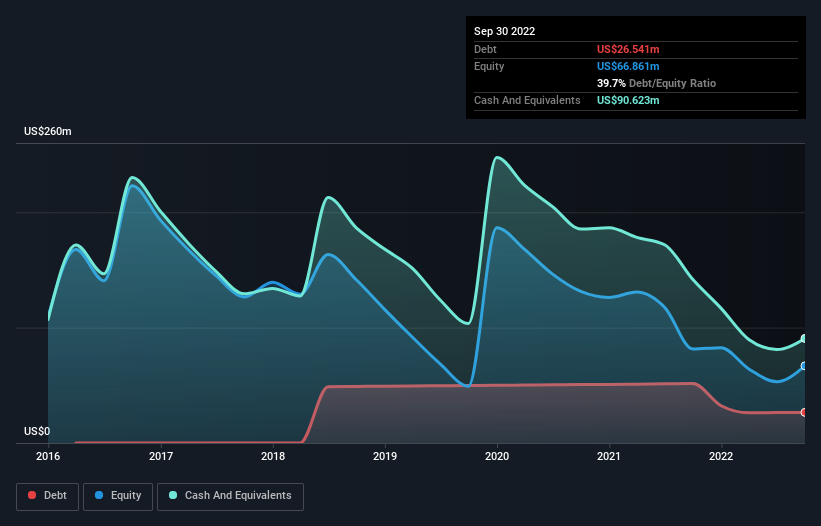
Legendary fund manager Li Lu (who Charlie Munger backed) once said, 'The biggest investment risk is not the volatility of prices, but whether you will suffer a permanent loss of capital.' It's only natural to consider a company's balance sheet when you examine how risky it is, since debt is often involved when a business collapses. We note that Ardelyx, Inc. (NASDAQ:ARDX) does have debt on its balance sheet. But the more important question is: how much risk is that debt creating?
What Risk Does Debt Bring?
Generally speaking, debt only becomes a real problem when a company can't easily pay it off, either by raising capital or with its own cash flow. If things get really bad, the lenders can take control of the business. However, a more common (but still painful) scenario is that it has to raise new equity capital at a low price, thus permanently diluting shareholders. Of course, plenty of companies use debt to fund growth, without any negative consequences. The first thing to do when considering how much debt a business uses is to look at its cash and debt together.
View our latest analysis for Ardelyx
What Is Ardelyx's Net Debt?
You can click the graphic below for the historical numbers, but it shows that Ardelyx had US$26.5m of debt in September 2022, down from US$51.5m, one year before. However, it does have US$90.6m in cash offsetting this, leading to net cash of US$64.1m.

How Strong Is Ardelyx's Balance Sheet?
The latest balance sheet data shows that Ardelyx had liabilities of US$52.0m due within a year, and liabilities of US$25.9m falling due after that. Offsetting this, it had US$90.6m in cash and US$5.21m in receivables that were due within 12 months. So it actually has US$18.0m more liquid assets than total liabilities.
This surplus suggests that Ardelyx has a conservative balance sheet, and could probably eliminate its debt without much difficulty. Simply put, the fact that Ardelyx has more cash than debt is arguably a good indication that it can manage its debt safely. There's no doubt that we learn most about debt from the balance sheet. But it is future earnings, more than anything, that will determine Ardelyx's ability to maintain a healthy balance sheet going forward. So if you're focused on the future you can check out this free report showing analyst profit forecasts.
Over 12 months, Ardelyx made a loss at the EBIT level, and saw its revenue drop to US$9.0m, which is a fall of 17%. We would much prefer see growth.
So How Risky Is Ardelyx?
Statistically speaking companies that lose money are riskier than those that make money. And we do note that Ardelyx had an earnings before interest and tax (EBIT) loss, over the last year. Indeed, in that time it burnt through US$124m of cash and made a loss of US$114m. But the saving grace is the US$64.1m on the balance sheet. That kitty means the company can keep spending for growth for at least two years, at current rates. Even though its balance sheet seems sufficiently liquid, debt always makes us a little nervous if a company doesn't produce free cash flow regularly. The balance sheet is clearly the area to focus on when you are analysing debt. But ultimately, every company can contain risks that exist outside of the balance sheet. To that end, you should learn about the 3 warning signs we've spotted with Ardelyx (including 2 which shouldn't be ignored) .
At the end of the day, it's often better to focus on companies that are free from net debt. You can access our special list of such companies (all with a track record of profit growth). It's free.
New: Manage All Your Stock Portfolios in One Place
We've created the ultimate portfolio companion for stock investors, and it's free.
• Connect an unlimited number of Portfolios and see your total in one currency
• Be alerted to new Warning Signs or Risks via email or mobile
• Track the Fair Value of your stocks
Have feedback on this article? Concerned about the content? Get in touch with us directly. Alternatively, email editorial-team (at) simplywallst.com.
This article by Simply Wall St is general in nature. We provide commentary based on historical data and analyst forecasts only using an unbiased methodology and our articles are not intended to be financial advice. It does not constitute a recommendation to buy or sell any stock, and does not take account of your objectives, or your financial situation. We aim to bring you long-term focused analysis driven by fundamental data. Note that our analysis may not factor in the latest price-sensitive company announcements or qualitative material. Simply Wall St has no position in any stocks mentioned.
About NasdaqGM:ARDX
Ardelyx
Ardelyx, Inc. discovers, develops, and commercializes medicines to treat unmet medical needs in the United States and internationally.
Exceptional growth potential and undervalued.
Market Insights
Community Narratives



